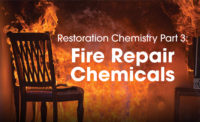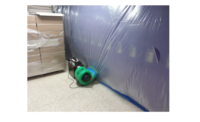Effective Use of Hydroxyl Radicals for Fire Damage Restoration

After the fire was burning aggressively, the lid of the barbeque grill was closed, with all the vents left open. Within seconds dense black smoke began pouring out of the grill even as the test chamber door was closed and sealed.

One minute after the door was sealed the smoke and fire residue nearly obscured the items in the test chamber.

By the end of the experiment not only was the air clear, but visible residue that had been observed on the walls of the test chamber had dissipated almost completely.



According to the National Fire Protection Association, it is estimated that some 370,000 home fires occur each year, costing close to $7 billion in total property damage. Many of these fires, however, start and are contained in a certain area of a home or business. Even though containment eliminates the necessity for complete demolition and reconstruction, it is still necessary for proper cleaning of soot and smoke in order to restore the property to a pre-loss condition.
Fire restoration is not as simple as some people would think. The soot, ash, and other fire residues are generally considered to be a health hazard. In addition, the contamination from fire can cause significant damage to parts of the structure not directly impacted by flames or burning. As the Institute for Inspection, Cleaning, and Restoration Certification (IICRC) notes in their summary of fire restoration:
“ Ash and smoke, if left unhindered, will cause extensive corrosion, etching and discoloration, not to mention lingering powerful odors.”
Dust collecting power tools, HEPA vacuums, specially formulated chemical cleaners and degreasers, foam applicators, smoke sponges, hot water extractors, ultrasonic cleaning machines, Esporta commercial wash units, encapsulants designed for fire damage, and a variety of other technologies and techniques perfected by the restoration industry are brought to bear on the problems caused by structure fires.
However, even with all this, lingering smoke odors can still be a problem.
Attacking the Odors in the Air
For decades, ozone generators have been used for odor in indoor environments, particularly related to fire damage. However, while the equipment is effective, there are ongoing concerns about safety – including dangers of ozone exposure for both people and some objects. Thus, there’s been an industry shift toward hydroxyl radical generators due to their ability to get rid of odors with far fewer side effects than ozone.
Early adopters of this technology bring in a lot of data showing that, not only did the hydroxyl radical generators address the odor, they did not have the same damaging effect on surfaces and contents as the ozone machines. Since hydroxyl radicals are not a recognized pollutant like ozone, numerous advertisements state that the generators are safe for use in occupied areas with proper monitoring.
Odorox Hydroxyl Group has provided a scientific description of hydroxyl radicals, which notes that, although they are extremely short-lived, they have the potential to produce a “cascade effect”. In layman’s terms, this means the hydroxyl radicals react with materials in the air or on nearby surfaces in a way that produces other unstable compounds. These secondary chemical mixtures continue to react with other things in the air until the more complex molecules are eventually broken down to simple substances such as carbon dioxide and water vapor. Because of this process, questions were raised regarding the safety of restoration workers and occupants in the presence of the intermediary chemicals. It has already been established that areas with high levels of volatile organic compounds (VOCs), like sites following a fire, can be unsafe for occupants. So the question now becomes, could the hydroxyl generators make the environment more dangerous by adding potentially harmful intermediates, or safer by rapidly reducing the harmful VOCs themselves?
Practical Science Used to Answer Important Questions
Odorox Hydroxyl Group understood the importance of having sound scientific evidence to support the safety of their hydroxyl generators and have it match up with the real world evidence of their effectiveness. They approached us at Wonder Makers to investigate the technology’s effectiveness and any safety concerns.
With the support of Odorox, a standard construction room with wooden studs and gypsum board finish was constructed. A number of different paint finishes were put on the walls to mimic diverse types of structures. A system was constructed that allowed a small, battery-operated sampling pump to be slid in and out of the room without a person entering or causing any appreciable amount of air to enter or exit during the sample change-out process.
Once everything was prepared and appropriate safety precautions were in place, a small fire was started inside the test chamber. After the fire was burning vigorously, a number of items were added that were representative of the sort of materials that would be impacted in a structure fire, including painted gypsum board, Romex wire, plastic electrical boxes, foam board insulation, nylon switch plates, and the like. As expected, the addition of such items to an active fire created a smoky mess.
After the room was sealed, it did not take very long for the fire to die out from lack of oxygen. When the fire had burned out, a hydroxyl generator was activated. Because of the small size of the room, the generator control was set to low, but the fan was run on high speed since the room was completely sealed and no artificial ventilation was introduced during the course of the experiment.
Five air samples to record levels of VOCs were collected at two-hour intervals. Three additional samples were collected after one day, two days, and five days. During the entire five-day test period, the room was not disturbed except to slide the sampling pump in and out through a double flap barrier to collect eight samples.
In addition to the highly sensitive samples (results were reported in nanograms per liter of air), extensive information was collected based on visual observations and olfactory perceptions. Multiple individuals were used to assist with evaluation of the strength and offensiveness of the odors generated by the fire and by operation of the Odorox hydroxyl generator.
An Interesting Experience
Burning things, even in a controlled situation, can be both nerve-racking and fascinating. Generally, the experiment proceeded according to plan.
Within twenty seconds of the door being sealed, smoke was present in every part of the test chamber. Within nine minutes, the smoke density was so great the sampling equipment situated within a foot of the entry point was totally obscured. Forty-eight hours after the burn (46 hours after the hydroxyl generator was turned on), the air in the test chamber appeared to be fairly clear, and a grayish/black residue was visible on the walls of the test chamber.
After five days without source removal or ventilation, but with the use of a hydroxyl generator, not only was the air clear and the smoke odor eliminated, but the visible residue that had been observed on the walls of the test chamber was almost completely gone.
The odor from the fire in the test chamber was described as “nasty plastic smoke,” “styrene,” “acrid,” and “sharp.” From an olfactory standpoint, the odor in the test room seemed to get worse a few minutes after the hydroxyl generator was turned on (two hours after the burn). The increase in intensity continued for several hours, and then tapered off, only to increase again in the time interval between 24 and 48 hours after the fire was out.
This increase in odor was attributed to the attack on the source materials that were left in the room. Five days after the fire (118 hours of hydroxyl generator operation), dramatic results had been produced. The fire odor had been eliminated and was replaced with a clean, fresh smell. Multiple individuals verified this observation. These findings were particularly impressive considering source materials were not removed and there was no outside air ventilation.
The sample results confirmed that a wide variety of noxious VOCs were formed with just a small fire. Outside ventilation was not undertaken as part of the experiment even though such a step is a normal part of fire restoration. Eliminating the ventilation created a worst-case scenario for the project and ensured that any decrease in VOCs or odors was a result of the hydroxyl radicals.
Total VOCs dropped from 48,000 nanograms per liter of air (ng/L) immediately after the fire to 2,600 ng/L after 8 hours, and then 1,600 ng/L five days later. There was a close correlation between the main components recovered from the first two samples collected; but the correlation weakened the longer the hydroxyl generator ran. For example, in the first two hours of generator run time, the top eight VOCs recovered had the same rank order as the VOCs recovered after the fire was extinguished (although at significantly lower levels after the generator was operating). After the hydroxyl generator had been operating for eight hours, only two compounds of the top 14 that were present when the fire was extinguished were recovered on an air sample.
Comparing Scientific Evidence to the Manufacturer’s Claims
As part of the preparation for the experiment, the manufacturer had provided substantial research indicating that significant quantities of hydroxyls are produced inside the chamber of the machine. Their literature stated that the Oasis+ unit would reduce smoke odors by reacting with airborne chemicals and breaking them down. They also made the claim that the hydroxyl generator would be able to eliminate the odors absorbed by the surfaces and contents in a room. They have made these claims despite the fact that hydroxyl radicals are so short lived that they do not actually circulate around the treatment area. Instead, the Odorox Hydroxyl Group re-affirmed information previously provided to the industry that hydroxyl radicals create other oxidizers, which leads to a cascade effect that completes the oxidation process.
The sample results clearly demonstrated hydroxyl radicals have a positive effect on the safety of an environment by dramatically reducing VOC levels after a fire. That breakdown creates byproducts, which confirms the science of the cascade effect. In this study, the quantities of all byproducts were significantly below OSHA standards, and were in the very low parts per billion range.
When paired with visual and olfactory results, the sample data indicates that source removal is critical for successful deodorization in a short period of time. The visual indication of soot breaking down off the walls at the same time that the odors and airborne levels of VOCs slightly increased suggests that after hydroxyl radicals break down the airborne contaminants, they begin working on surface materials. This theory is further supported by the fact that soot is incomplete oxidation of the source materials that were burned. Therefore, restoration contractors who utilize a hydroxyl generator should see a reduction in odors when the machine is first utilized, but might encounter an increase in pungent smells as the machine continues to operate unless all of the charred materials and soot have been removed. Such olfactory variations could actually act as a quality control measure to verify whether all of the fire-damaged building materials have been properly removed.
Source Removal and Ventilation Reduce Risk and Speed Deodorization
Although scientific data can always be subject to various interpretations, this experiment did lead to some practical recommendations for the fire restoration process. It is clear that the use of the hydroxyl generator sped up the process of VOC removal. It was obvious that the room was free of unpleasant odors and had a fresh scent by the end of the experiment, despite the fact that source material remained and there had been no outside air ventilation. It was surprising to note the visible reduction in surface contamination without any physical removal efforts.
Despite the positive results when setting up the experiment as a worst-case scenario, it is recommended that the use of a hydroxyl generator be employed in conjunction with ventilation and source removal. In addition to utilizing a hydroxyl generator to lower the VOC levels to ambient outdoor levels, following standard restoration protocols to first ventilate the space and quickly remove any burnt materials would be better than requiring the machine to do all the work of odor reduction by itself.
Another clear conclusion from the study is that there is a close correlation between olfactory and laboratory assessments of airborne contaminants after a small structure fire. When the odors were strongest, the VOC levels were at their highest. The olfactory evaluation also appeared to detect the change in types of compounds as the hydroxyl reaction process progressed. Since the olfactory assessment is conducted in real time, it is a faster method than chemical sampling to determine the general timeframe for when it is safe to phase out protective equipment. This provides strong support to the restoration industry approach of using an absence of smoke odors as their primary evaluation tool to gauge the effectiveness of a fire repair effort and the overall air quality for contractors and occupants.
Again, we provide the recommendation from these results that fire restoration workers should use PPE until the heavy smoke odor is eliminated. While there were no specific VOCs measured near the OSHA exposure limits, the total VOCs and strength of odor at the beginning of this experiment would be considered above the safety guidelines provided by indoor air quality experts.
We conclude that hydroxyl generators do not exacerbate the safety risk one encounters in post-fire environments. Instead, they rapidly break down complex compounds and expedite the cleaning process.
Looking for a reprint of this article?
From high-res PDFs to custom plaques, order your copy today!










